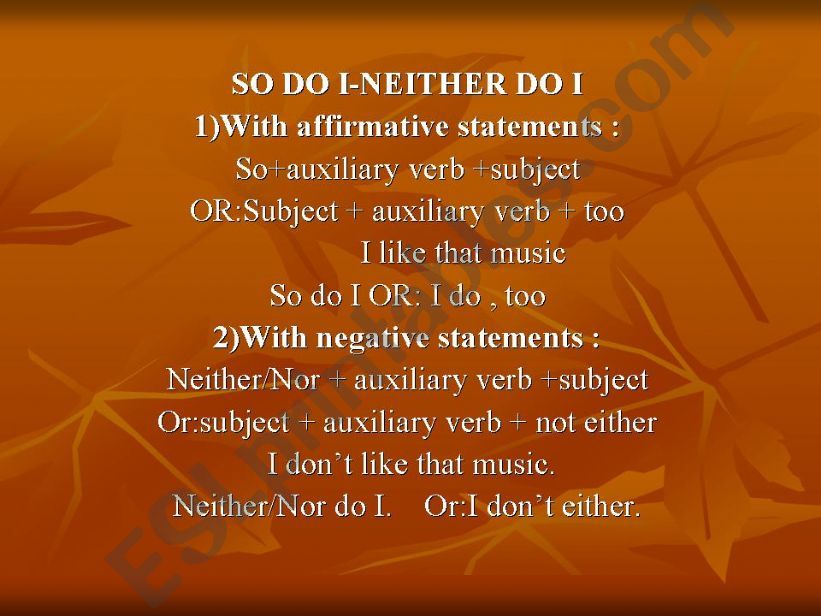
ESL English PowerPoints SO NEITHER
: English Grammar SO - NEITHER How to use 'so' and 'neither' in English. SO SO is used to show agreement with affirmative statements concerning the speaker or another person. SO + Auxiliary + Subject (pronoun) : So do I Remember : The Auxiliary in the response must agree with the verb tense in the original statement. Here are some examples :

English Intermediate I So and Neither
1 - I don't like mushrooms. Neither don't I So do I Neither do I 2 - I love going to the cinema. So am I I can So do I 3 - I can't swim. Neither can I I can Neither do I 4 - I haven't got a dog Neither have I So have I I have

SO AND NEITHER English ESL worksheets pdf & doc
English grammar exercises to practice the difference between SO and NEITHER IN English when agreeing with someone.A statement (said by person A) appears on t.
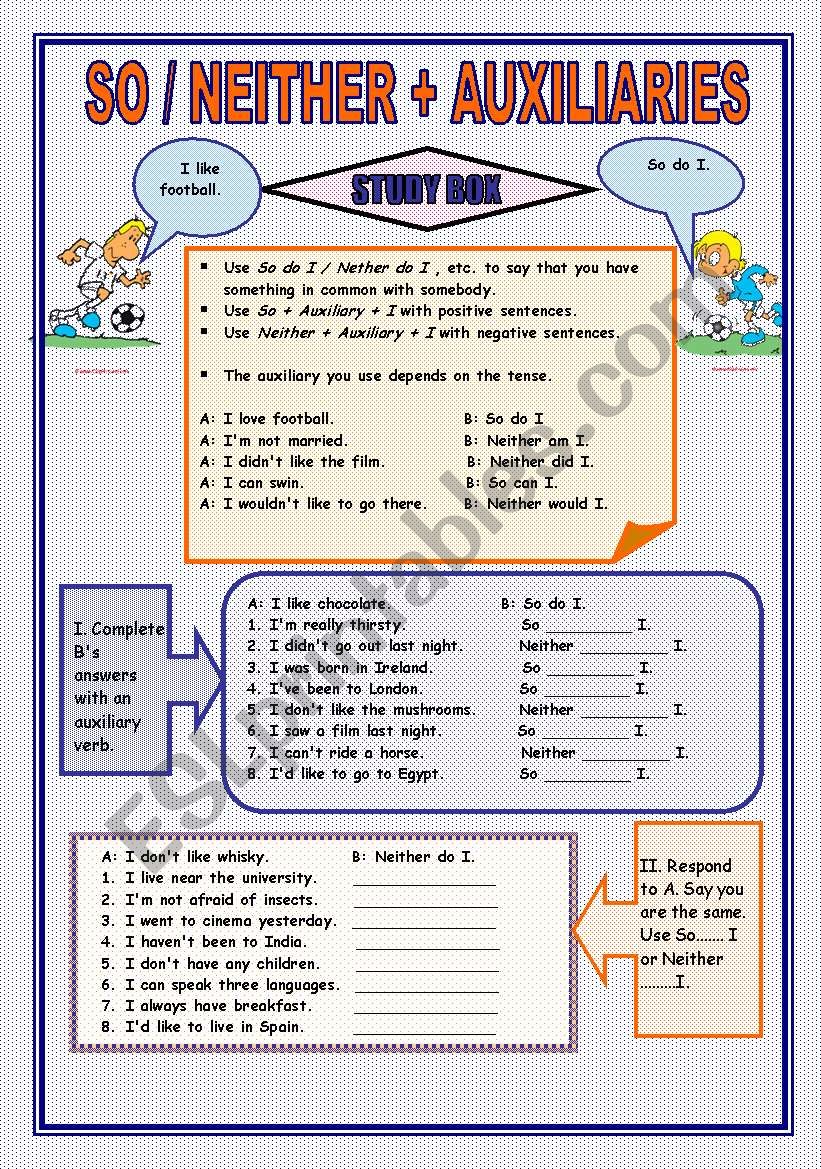
SO / NEITHER + AUXILIARIES (key included) ESL worksheet by moni_k
Well, James is here to explain when to use 'so' and when to use 'neither' to show agreement.Watch the. How can you show you agree with what someone has said? Well, James is here to explain.
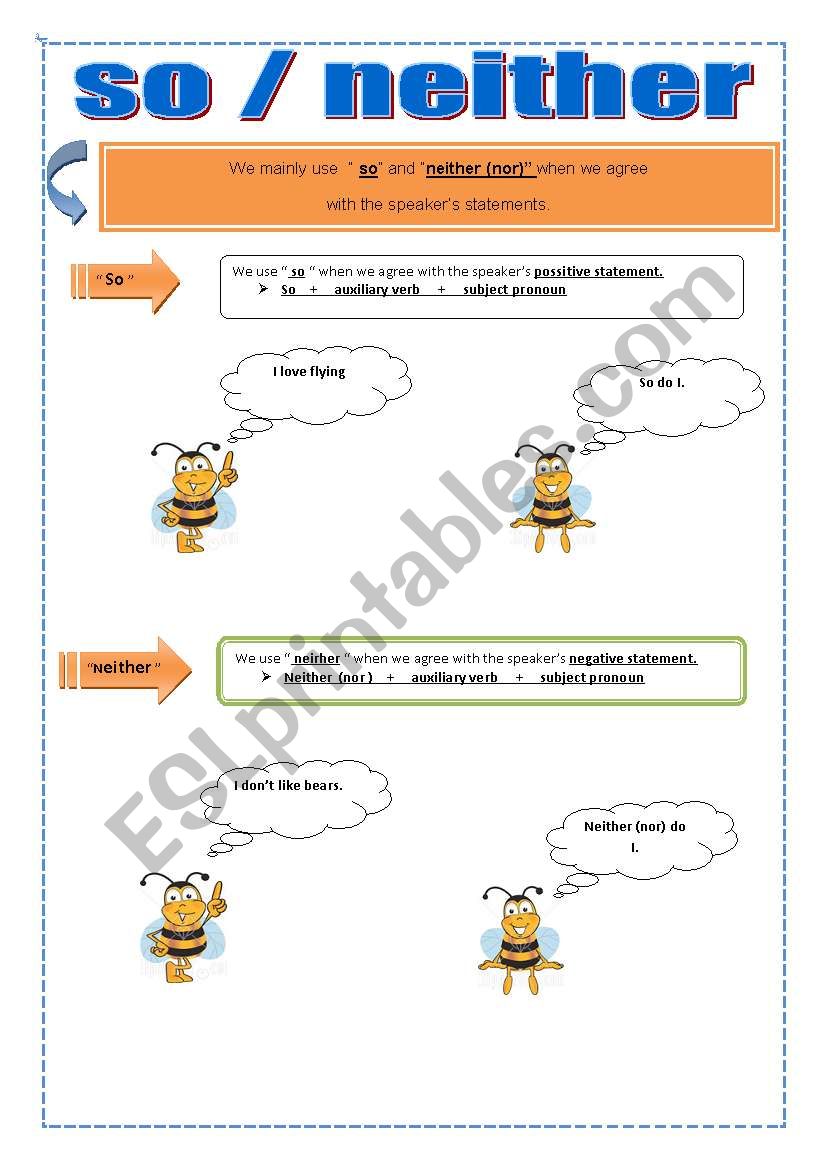
So / Neither ESL worksheet by turac
Neither Neither is used to agree with a negative statement: Mark: 'I don't like classical music.' Fred: 'Neither do I.' As with 'so' the auxiliary in the reply with 'neither' agrees with the statement: A: I don't speak Russian. → B: Neither do I. A: Peter isn't happy. →B: Neither am I. A: I can't play any musical instruments. →B: Neither can I.

So/ neither grammar worksheet
So and Neither with Perfect Expressions. If we use a perfect expression (HAVE + Verb - en as in have eaten, had stolen, will have bought) in the first sentence, we follow so or neither by the appropriate form of HAVE or MODAL + HAVE. Bill has eaten too much. So has Mary. Bill had eaten too much. So had Mary.
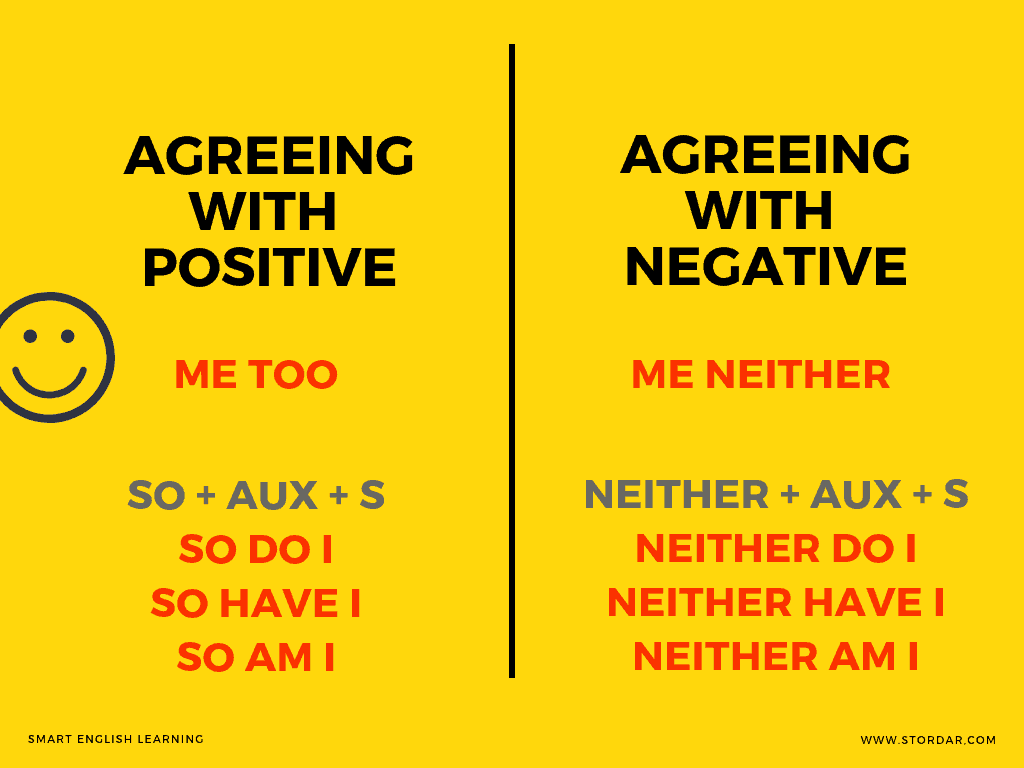
03 So do I / Neither do I Figure Out English podcast
So, neither - so am I, neither do I, etc. Exercise 1 Choose the correct forms with so, neither, too, either to complete the sentences below. 1 A: 'I haven't written the essay yet.' B: 'Neither I.' 2 A: 'I'm very thirsty.' B: ' .' 3 A: 'Sam won't help us.' B: 'Neither . 4 A: 'I can't forgive them for what happened.' B: 'I can't forgive them .'
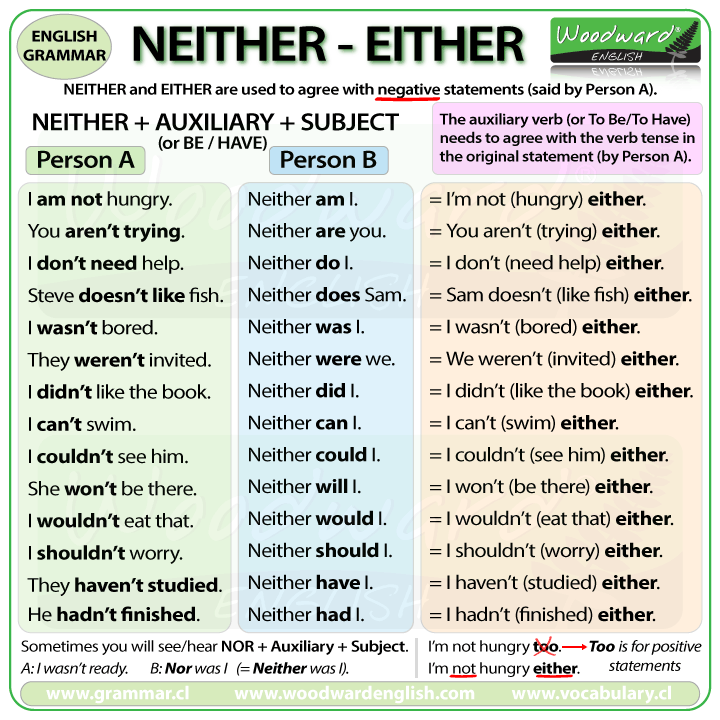
So Neither Either differences English Grammar Rules
So, too, either, neither: this is often used as a reply to someone else in a conversation, but both sentences can also be said by the same person, and even joined together. "So" and "too" are used in positive sentences to show agreement. Auxiliary (do/ does/ have/ should/…) I love football. I love football, too.

SO and NEITHER Teaching Resources
Neither is used to show agreement with negative statements. Neither + Auxiliary + Subject (pronoun) The Auxiliary needs to agree with the verb tense in the original statement. It is similar to using either at the end of a sentence, although Neither is more commonly used, especially in spoken English. A: I don't understand Spanish.

Click on AGREEING SO, TOO / EITHER, NEITHER
So / neither / nor in short answers 'I'm looking forward to the picnic.' 'So am I.' The statement is grammatically positive, so we replay with So. 'I haven't seen Paul today.' 'Neither have I. The statement is grammatically negative, so we replay with Neither or Nor. Statements comparing people Tim wants to go and so does Janet.
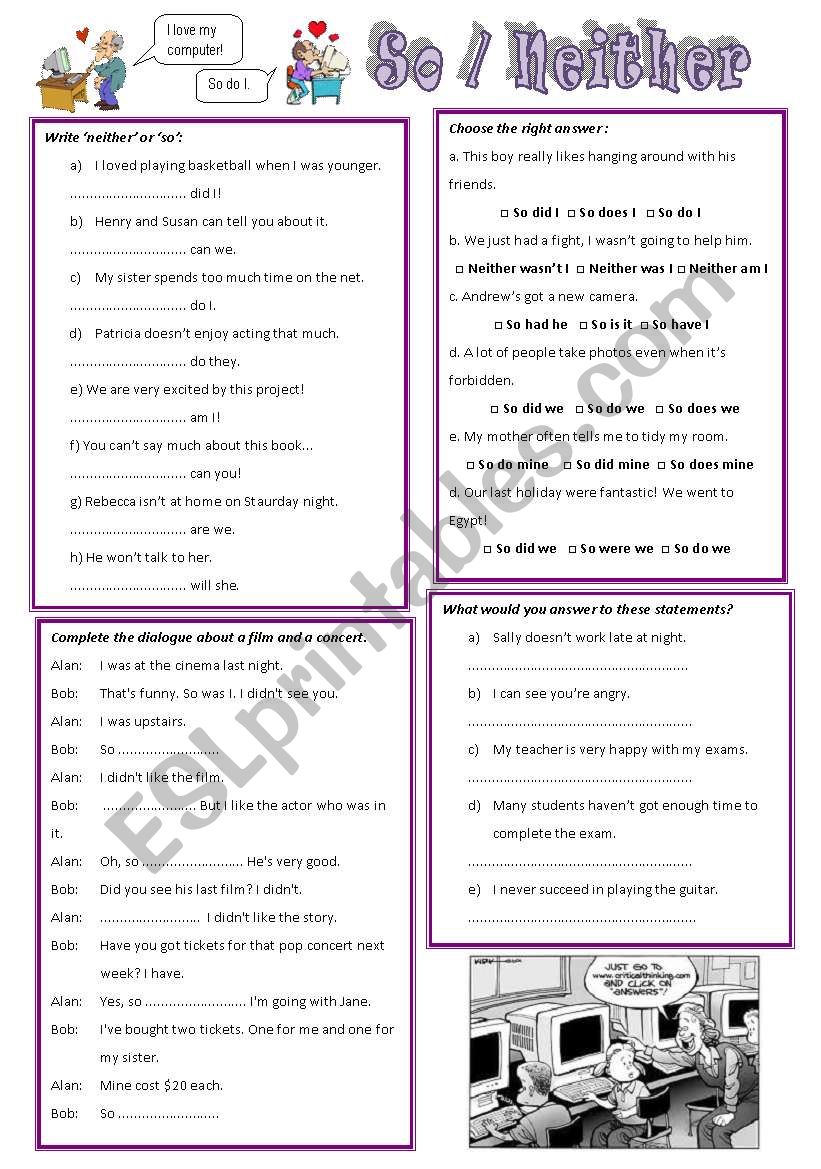
So Neither ESL worksheet by danis
1. Using 'So' Grammar: So + auxiliary/modal verb + pronoun Note: We should pay attention to the verb tense used in the statement while choosing our auxiliary form. 2. Using 'Too' Grammar: Pronoun + auxiliary/modal verb + Too In Negative Statements 1. Using 'Neither / Nor' Grammar: Neither (nor) + auxiliary/modal verb + pronoun Note:

English Intermediate II U6Responses with so and Neither
So - English Grammar Today - a reference to written and spoken English grammar and usage - Cambridge Dictionary

So / Neither English learning spoken, Third grade reading worksheets
The particle so is used when the statement of reference is an affirmative sentence, while neither is used when it is a negative sentence. - Sara: I have got a new jacket. - Mary: So have I. - John: I don't eat meat. - Emma: Neither do I. Anuncios 3. Structure of so (am) I and neither (am) I

SO / NEITHER English ESL worksheets pdf & doc
The verb after 'so' or 'neither' changes depending on the tense of the verb in the first sentence. (This is very similar to tag questions ). What about 'too' and 'either'? We can also use 'I do too' and 'I don't either', which mean the same as 'so do I' and 'neither do I': John: I hate mushrooms. Me: I do too (=I also hate mushrooms).

LESSON 48 CÓMO USAR TOO EITHER SO NEITHER EXPLICACIÓN DE TOO EITHER
So / Neither / Too - How to agree in English Shayna Oliveira Grammar "I love strawberry ice cream." - "Me too!" Free Download: 500+ English Phrases Me Too / Me Neither The easiest way to agree in English is to say "Me too" (to agree with a positive statement) or "Me neither" (to agree with a negative statement): "I love strawberry ice cream."

So and neither general gramma… English ESL powerpoints
5 Neither is the opposite of so. Other alternatives: I won't/will not (accept bribes) either. Me neither. (informal) 6 But is more emphatic than and. 7 Informally, we can use a plural verb after neither and either + of + a pronoun (or a determiner + a plural noun): Neither of them go (es) to church regularly.